Check out these amazing hotel deals!
- Save up to 30% on your hotel in Hawaii!
- Last-minute holiday hotel deals
- Top hotel deals for a new year trip
- Visiting Paris? Find the Best Deals & Reviews at TripAdvisor.
- Save 30% on hotels in Ocean City, Maryland...a TripAdvisor Top 10 Summer Destination!
- Save up to 30% on your hotel on your Winter Vacation!
- Find top-rated hotels at the lowest prices on TripAdvisor. Check rates now!
- Save up to 30% on hotels for a romantic getaway!!
The largest stadiums in the world, scattered across the globe, offer great capacity and different designs and styles. From Australia to the United States, from India to England, these huge facilities host different sports such as American football, cricket, and soccer. Also, events of various kinds, such as musical concerts by world-famous artists like Madonna, Spice Girls, and Pink Floyd have been organized there. Some are more famous than others for hosting the historic World Cup finals, others for being home to some of the most amazing goals in football history.
All these things are a reason why you should visit them and admire them in all their splendor. If you never knew which are the largest ones, take a look at the table below, you will find the 20 largest stadiums in the world!
| Stadium name | Capacity | City-state | Pos. |
| Salt Lake Stadium | 85,000 | Calcutta, India | 20 |
| Borg El Arab | 86,000 | Alexandria, Egypt | 19 |
| Bukit Jalil National Stadium | 87,411 | Kuala Lumpur, Malaysia | 18 |
| Gelora Bung Karno Stadium | 88,083 | Jakarta, Indonesia | 17 |
| Wembley | 90,000 | London, England | 16 |
| The Rose Bowl | 92,542 | Pasadena, California | 15 |
| FNB Stadium | 94.736 | Johanessburg, South Africa | 14 |
| Azadi Stadium | 95.225 | Tehran, Iran | 13 |
| Estadio Azteca | 95,500 | Mexico City, Mexico | 12 |
| Camp Nou | 99.354 | Barcelona, Spain | 11 |
| Melbourne Cricket Ground | 100,024 | Melbourne, Australia | 10 |
| Darrell K Royal, Texas Memorial Stadium | 100.199 | Austin, Texas | 9 |
| Bryant-Denny Stadium | 101,821 | Tuscaloosa, Alabama | 8 |
| Tiger Stadium | 102.321 | Baton Rouge, Louisiana | 7 |
| Neyland Stadium | 102,455 | Knoxville, Tennessee | 6 |
| Kyle Field | 102.733 | College Station, Texas | 5 |
| Ohio Stadium | 104.944 | Columbus, Ohio | 4 |
| Beaver Stadium | 106,572 | University Park, Pennsylvania | 3 |
| Michigan Stadium | 107,601 | Ann Arbor, Michigan | 2 |
| Rungrado May Day Stadium | 150,000 | Pyongyang, South Korea | 1 |
20. Salt Lake Stadium, Calcutta
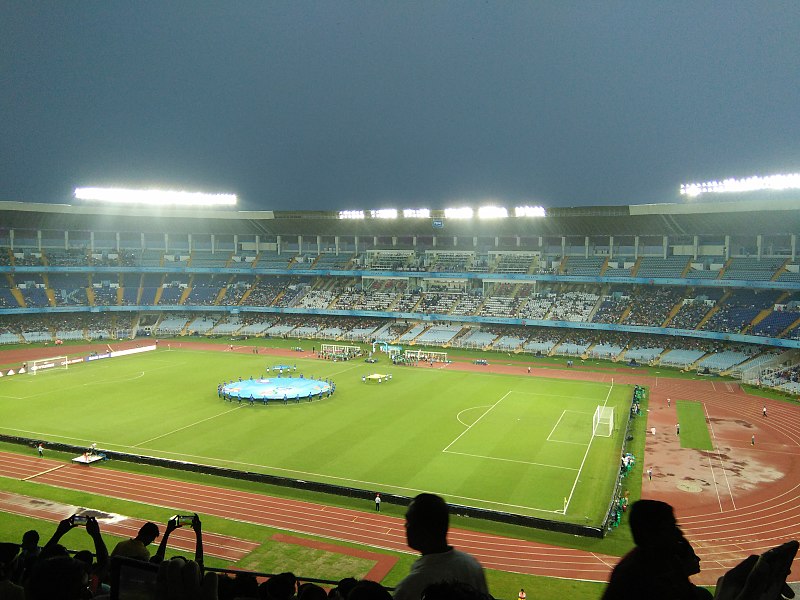
Capacity: 85,000
Year of construction: 1982
Hosted teams: Mohun Bagan AC, Kingfisher East Bengal FC, Prayag United SC, and Mohammedan SC. (football)
Also known as Vivekananda Yuba Bharati Krirangan (VYBK), it is the largest stadium in entire India. It has an elliptical-shaped structure with three rings. It was built in 1984 to host not only football matches and athletics competitions but also musical concerts, ballets, and other sporting events such as those of amateur and professional climbers (on the north side of the Stadium). However, the most popular sport is football, as the facility hosts the home games of the following local Indian teams: Mohun Bagan AC, Kingfisher East Bengal FC, Prayag United SC, and Mohammedan SC.
During the derbies, the atmosphere gets really hot, the wait is incredible and, in some circumstances, episodes of violence between fans happen. The most important international football event was held in 2011 with the FIFA match between Argentina and Venezuela.
19. Borg El Arab, Alexandria, Egypt
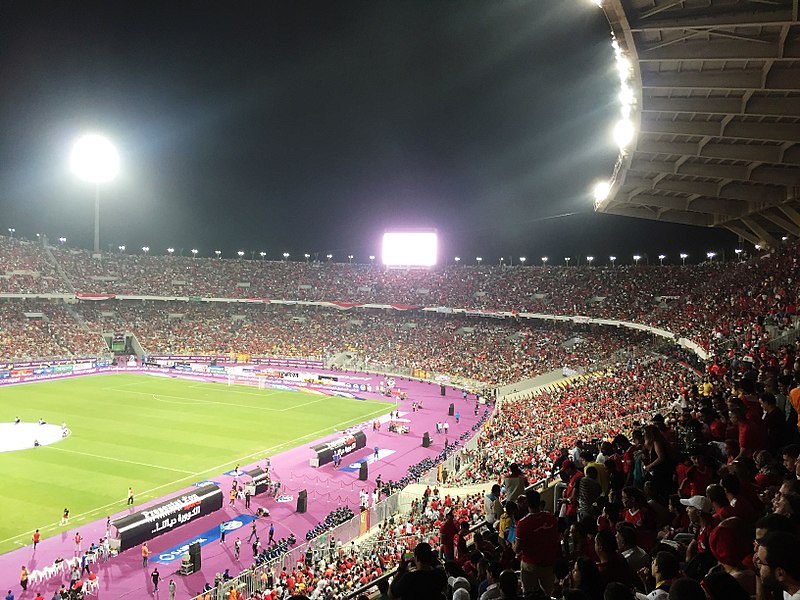
Capacity: 86,000
Year of construction: 2006
Hosted teams: Egyptian national football team, Smoutha
A modern stadium recently built for the 2009 Under 20 World Cup and the largest one in entire Egypt. The home team of Al Ittihad plays in the Borg El Arab; famous for hosting the opening match of the Under 20 World Cup, it was originally commissioned in 2006 with an ambitious international project to aim to host the 2010 FIFA World Cup, a project that unfortunately failed.
Therefore, it was decided to use the stadium as the home of the Egyptian national team together with the international stadium in Cairo. Apart from the national team, Smoutha, the team from Alexandria also plays here.
Fun fact: the stadium was designed and built entirely by the Corps of Engineers of the Egyptian Armed Forces.
18. Bukit Jalil National Stadium, Kuala Lumpur
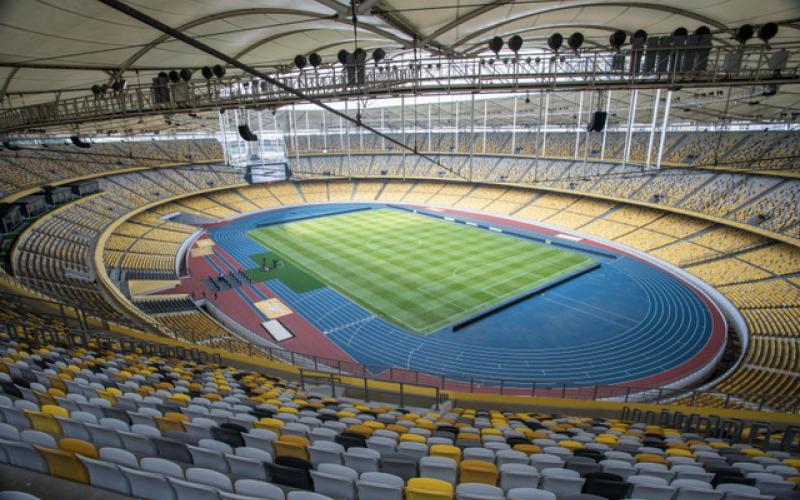
Capacity: 87,411
Year of construction: 1995
Hosted teams: Malaysia national football team
The stadium was built for the Commonwealth Games in 1998, but the South East Asian Games in 2001, some matches of the Malaysia national football team, and the Asian Nations Cup in 200 were also held there. It was inaugurated on July 11, 1998, by the 4th Minister of Malaysia, Tun Dr. Mahathir Mohamad, on the occasion of the Commonwealth Games.
In addition to sporting events, it also hosts national and international football matches such as the Malaysia FA Cup, Malaysia Cup, as well as musical concerts.
17. Gelora Bung Karno Stadium, Jakarta
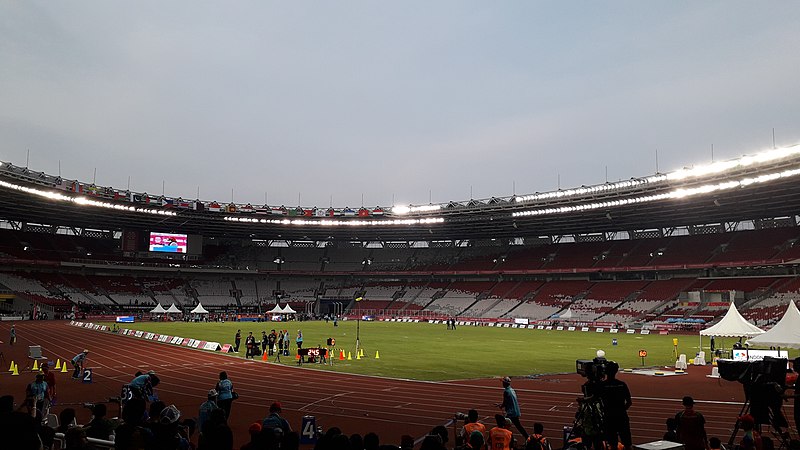
Capacity: 88,083
Year of construction: 1960
Hosted teams: Indonesia national football team, Persija Jakarta
It’s the largest stadium in Southeast Asia inaugurated in 1962. and its construction cost about 20 million dollars. It’s named after Sukarno, the first president of Indonesia, and is mainly used for football matches, especially those of the National team of Indonesia.
The first games that were hosted there were those of the 1962 Asian Games; the other most famous matches were those of the AFC Asian Cup in 2007 between Iraq and Saudi Arabia, those of the Asian Games of 2018, and the Para Asian Games. Other competitions include the Tiger Cup and National Cup finals.
16. Wembley, London
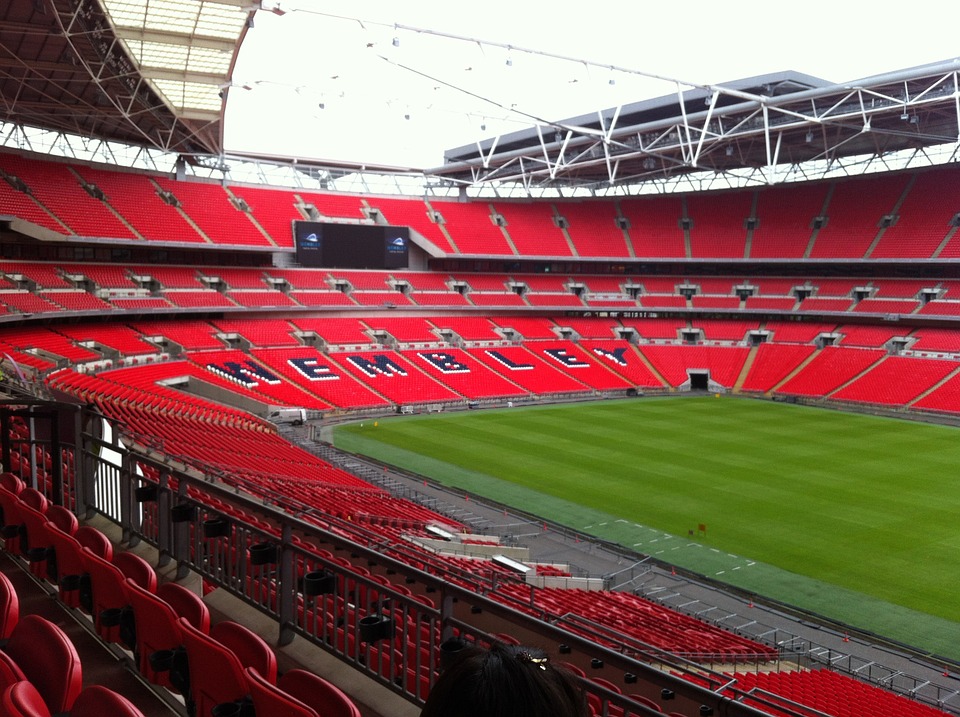
Capacity: 90,000
Year of construction: 2003
Hosted teams: England national football team
Wembley replaced the old one (which was demolished) in 2007. The venue hosts football, rugby, and athletics matches. The symbol of the new stadium is the steel arch built above the North Stand (main grandstand) while the previous one was the twin towers. Thanks to its dimensions, 133 meters by 315 meters, it plays a fundamental role in shaping the new London skyline.
The most important football matches played at Wembley include those of the 2012 Olympic Games, the 2011 UEFA Champions League finals between Barcelona and Machester United and the 2013 match between Borussia Dortmund and Bayern Munich; for rugby matches, we mention those of the Rugby World Cup 2015. Wembley also often hosts concerts of global importance, including those of George Michael, Muse, Madonna, Live Earth, Take That, Ed Sheeran, and recently, the Spice Girls with their latest SpiceWorld tour 2019.
15. The Rose Bowl, Pasadena
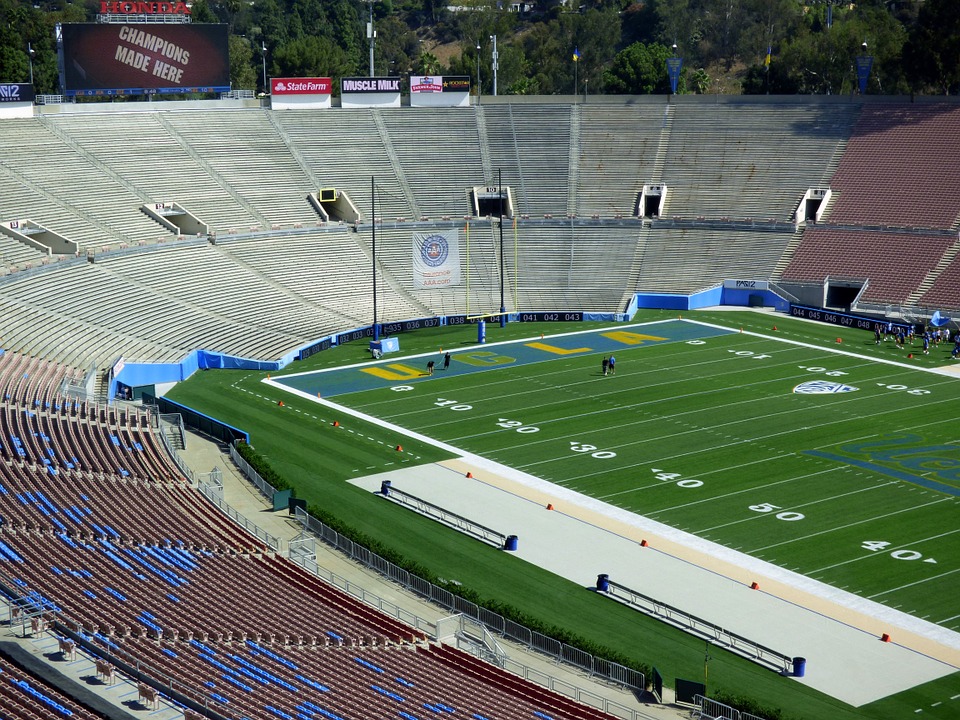
Capacity: 92,542
Year of construction: 1922
Hosted teams: Rose Bowl Game, UCLA Bruins (American football)
The largest American football stadium in the United States, famous for hosting the World Cup when Italy lost from Brazil on penalties. Officially recognized as a historic monument, the stadium hosts the games of the Pac-12 Conference (which brings together 12 universities in the western United States), the bowl game, the university football a.k.a. Rose Bowl Game, ad the matches of the UCLA University Bruins.
The facility was also used for football matches until 2003; among the most important matches played are those of the 1984 Los Angeles Olympics, the 1994 World Cup with the final and the one for 3rd place between Bulgaria snd Sweden, and the 1999 women’s World Cup final between the USA and China. Major non-sporting events include major concerts held by Depeche Mode, The Cure, and Pink Floyd.
14. FNB Stadium, Johannesburg
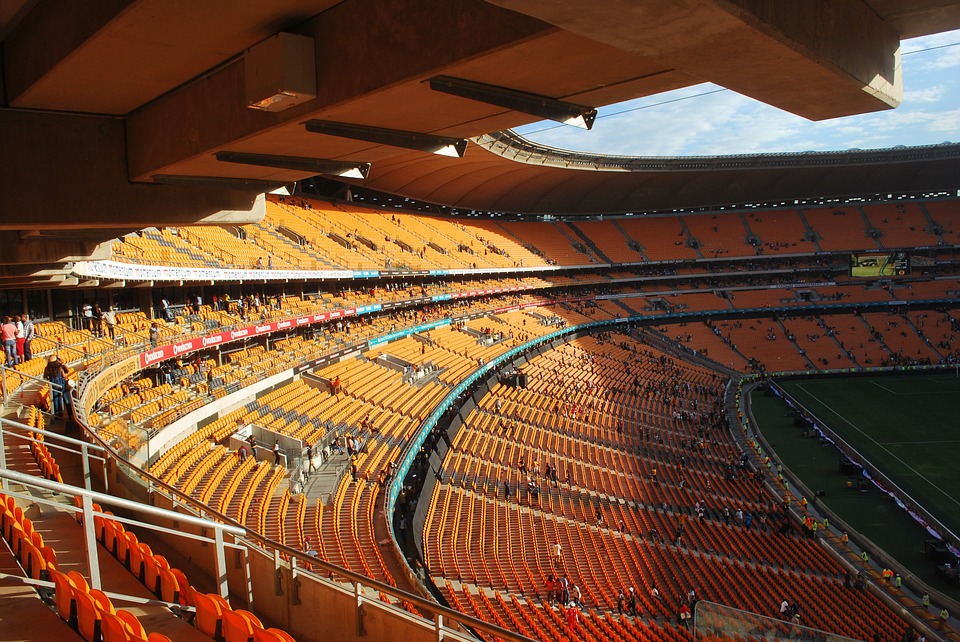
Capacity: 94,736
Year of construction: 1986
Hosted teams: South Africa national football team, Kaizer Chiefs Football Club, South Africa 15-a-side rugby team
The First National Bank Stadium, known simply as FNB Stadium, Soccer City, or even “The Calabash” due to its shape recalling a typical African pot. It was built in 1987 and renovated and extended in 2009 for the 2010 World Cup: it hosted the first match between South Africa and Mexico and the final between Spain and the Netherlands.
The facility hosts Kaizer Chiefs Football Club home football matches, South Africa national football team matches, and South Africa 15-a-side rugby team matches. The stadium has a very important historical value: here Nelson Mandela gave his first speech in 1990 after his release from captivity and appeared for the last time in public before his disappearance for the final ceremony of the 2010 World Cup. In 2013, his commemoration was there.
13. Azadi Stadium, Tehran
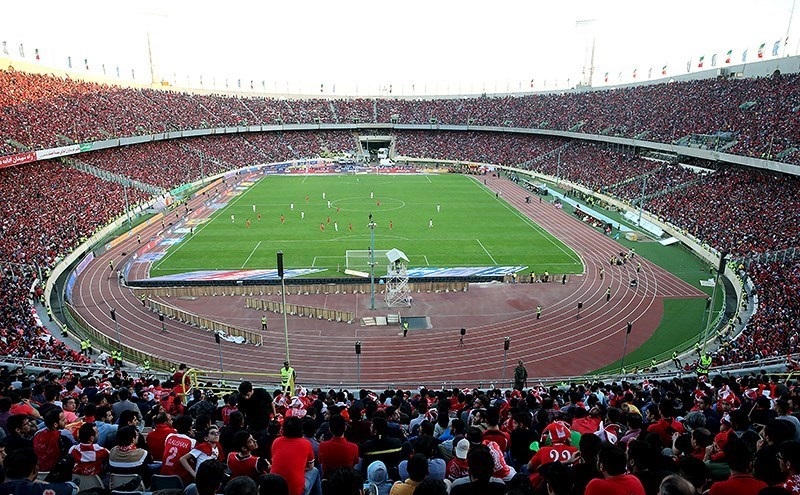
Capacity: 95,225
Year of construction: 1971
Hosted teams: Persepolis FC, Esteghlal FC Iranian National Football Team
The official stadium of Tehran in Iran was inaugurated in 1971 to host the 1974 Asian Games. The attendance record was recorded for the play-off of the 1998 World Cup in France for the match between Iran and Australia with 120,000 people. The stadium is located in the center of the city and is part of the large Azadi sports complex, used for football, swimming, volleyball, weightlifting, and even rowing (the center also includes a river). It’s used to host the matches of the Iranian national football team, Esteghlal FC and Persepolis FC, both in the top division of the Iranian football championship.
In 2005, unfortunately, there was a tragic accident during the match between Iran and Japan that cost the lives of 5 people and injured 40 other people due to the overcrowding of fans in the stands. Furthermore, since 1982, there was a ban on access to the stadium for women. The 2018 World Championship match between Iran and Spain was the first time women were allowed to enter the stadium since the 1979 revolution.
12. Aztec Stadium, Mexico City
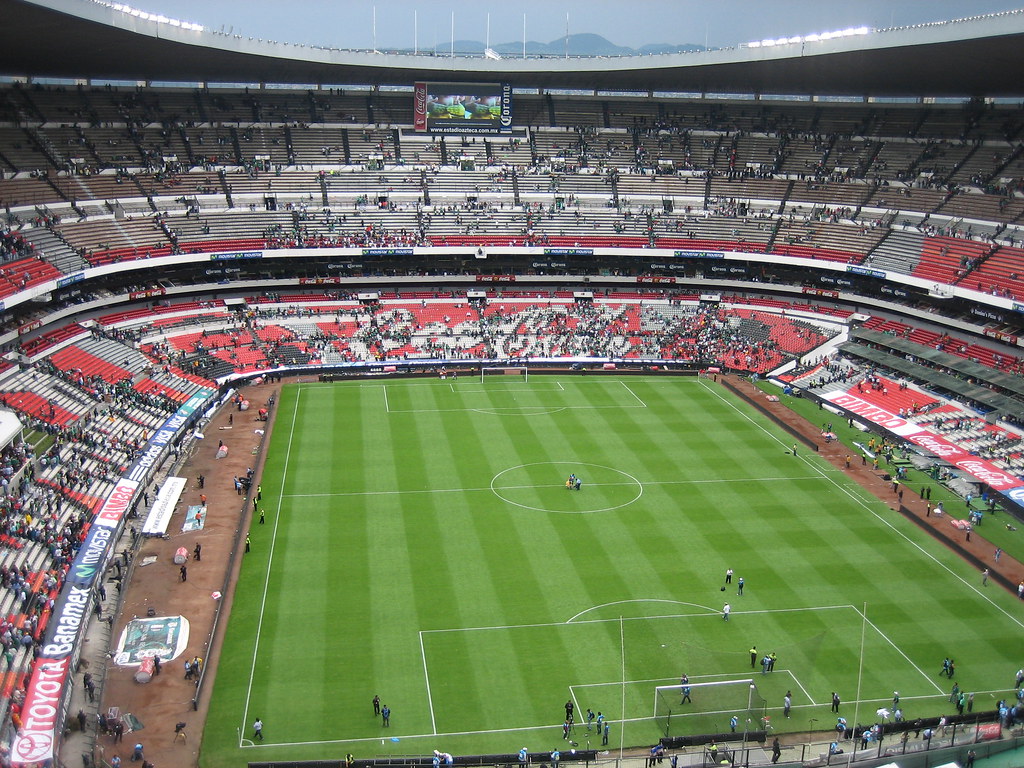
Capacity: 99,500
Year of construction: 1963
Hosted teams: Club Amèrica, Mexico national team (football)
It hosts the home matches of Club Amèrica and often those of the Mexican national football team. The stadium is also known as Santa Ursula, from the homonymous neighborhood where it’s located, but also as Guillermo Cañedo; however, its official name was given in honor of the Aztec civilization. It’s a unique stadium of its kind since it hosted two finals of the soccer World Cup, one in 1970 and one in 1986. Moreover, it hosted the most games ever in the final phase of a World Cup.
The stadium also held the final of the Olympic football tournament in 1968, that of the CONCACAF Gold Cup, and the semifinal of the 1970 World Cup between Italy and West Germany, which Italy won and went down in history as the “Game of the Century”. It was made even more famous by the goals scored by Diego Maradona, one with one hand to England and the other a few minutes, which is considered the “goal of the century”.
11. Camp Nou, Barcelona
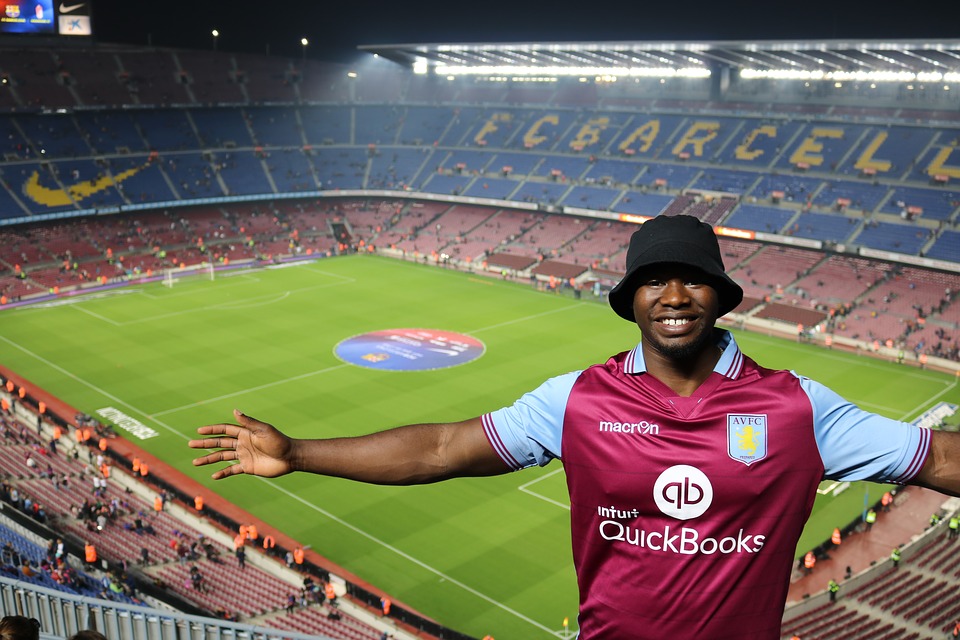
Capacity: 99,354
Year of construction: 1954
Hosted teams: FC Barcelona (football)
It is the stadium where the football team Barcelona has played their games since 1957. It’s the largest stadium in Spain as well as in Europe. Until 2001, it was officially called Estadio de Futbol Club Barcelona (eng. Football Club Barcelona Stadium), then simply as Camp Nou through a referendum between club members. It has hosted two Uefa Champions League finals: in 1989 between Milan and Steaua Bucharest and in 1999 between Manchester United and Bayern Munich; numerous finals of the Copa del Re; and finals of the 1982 World Cup and 1964 European Championship.
Among the most famous and important concerts, we find those of Michael Jackson, Julio Iglesias, U2, Bruce Springsteen, the benefit concert organized by Amnesty International, and the Concert of the Three Tenors Josep Carreras, Placido Domingo, and Luciano Pavarotti. The Camp Nou also hosted a Mass by John Paul II for honorary citizenship of Barcelona in 1982 and a Dirk Bikkembergs fashion show.
10. Melbourne Cricket Ground, Melbourne
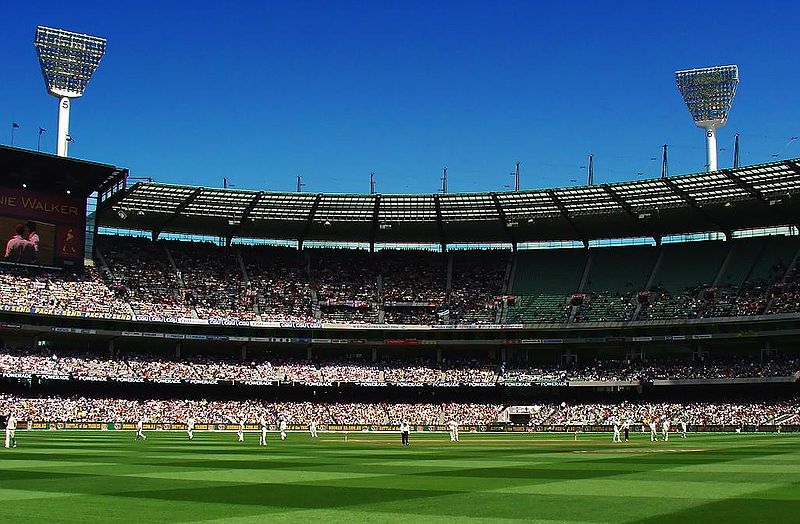
Capacity: 100,024
Year of construction: 1853
Hosted teams: Richmond Tigers, Melbourne Demons, Hawthorn Hawks, Collingwood Football Club, Essendon Bombers (Australian football), Victoria and Melbourne Renegades (cricket)
Opened in 1853, this stadium hosts cricket and Australian football matches, the most popular sport in Australia; the field is oval in shape and there are two teams of 18 players. Over the years, the stadium has also hosted world-class events such as the Rolling Stones, U2, Michael Jackson and Madonna concerts, rugby and national football matches, and official visits by Queen Elizabeth II and Pope John Paul II. In 1959, a record number of 143 thousand people was recorded at the religious ceremony of the preacher Billy Graham. The stadium, in 1869 and 1878, also hosted tennis matches and cycling competitions.
9. Darrell K Royal, Texas Memorial Stadium, Austin
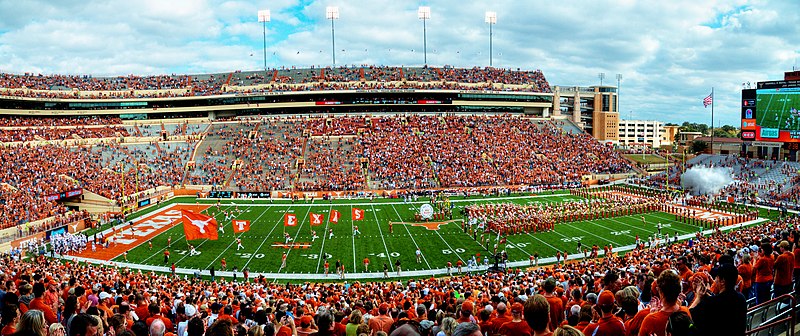
Capacity: 100,199
Year of construction: 1924
Hosted teams: Texas Longhorns (American football)
Apart from being one of the largest stadiums in the world, it also has one of the largest scoreboards, measuring 25×41 meters, which is why it was nicknamed Godzillatron. In fact, in 2014, when it was installed, it was the largest HD screen in the world which was surpassed by another screen in Tokyo. But, the story of Godzillatron doesn’t end here. The stadium was harshly criticized by its fans for being too loud and full of publicity, which is why it was renamed ADzillatron. Opened in 1924, it was originally built by Theo Bellmont, athletic director of the home football team, the Texas Longhorns, and was funded by students for a total cost of $275,000. The game with the most spectators was played in 2016 at the match between Texas Longhorns and Notre Dame.
8. Bryant-Denny Stadium, Tuscaloosa
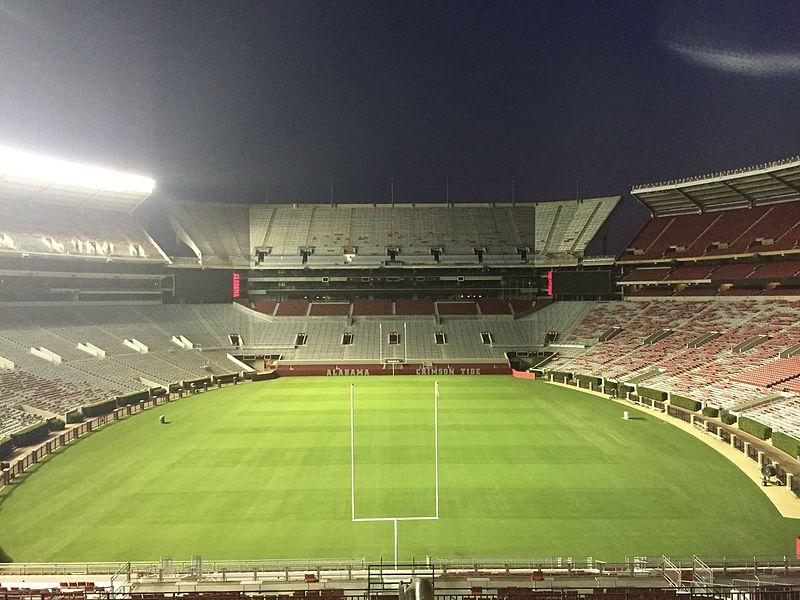
Capacity: 101,821
Year of construction: 1928
Hosted teams: Alabama Crimson Tide (American football), Alabama High School Athletic Association (athletics)
Inaugurated in 1929, it was dedicated to the memory of George H. Denny, president of the University of Alabama in Tuscaloosa for 20 years (1912-1932). In 1975, the stadium added “Bryant” to its name, as recognition to Paul “Bear” Bryant, historic coach of Alabama Crimson Tide, the home team that plays in this stadium. In addition to the American football team, the stadium is also home to the Alabama High School Athletic Association, the state’s athletics team. A renovation with new sports facilities and displays was planned for 2020.
7. Tiger Stadium, Baton Rouge
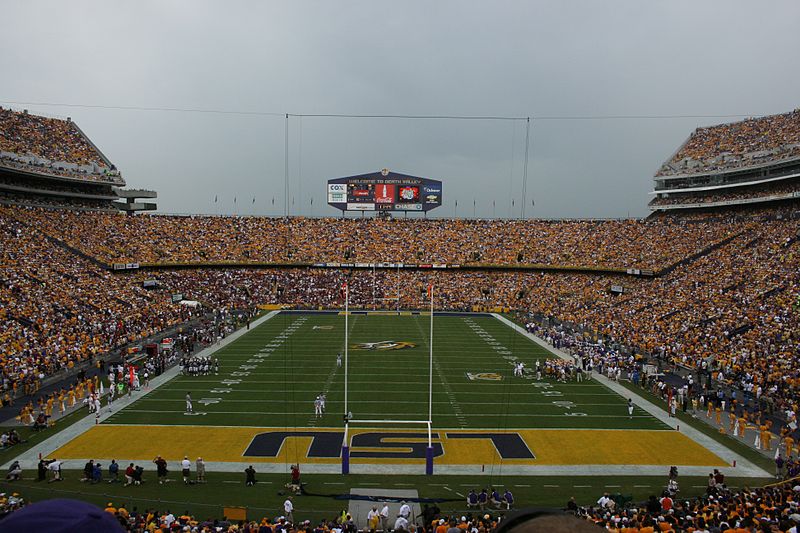
Capacity: 102,321
Year of construction: 1924
Hosted teams: LSU Tigers (American football)
It was inaugurated in 1924 and today mainly hosts football games: the LSU Tigers play their home games here. It’s called Death Valley due to the noise coming from the stands during sporting events. The famous phrase by Paul “Bear” Bryant, a famous college football player and coach, “Baton Rouge is the worst place in the world for a visiting team: it’s like being inside a drum.” best explains it and sums up the numerous victories of the home team in the stadium and the fear of the opponents towards them. On a crossbar, the word WIN has been painted and it’s a tradition that the players touch it before starting their match. The stadium also has the uniqueness of having H-shaped doors, not Y-shaped like most of the stadiums.
6. Neyland Stadium, Knoxville
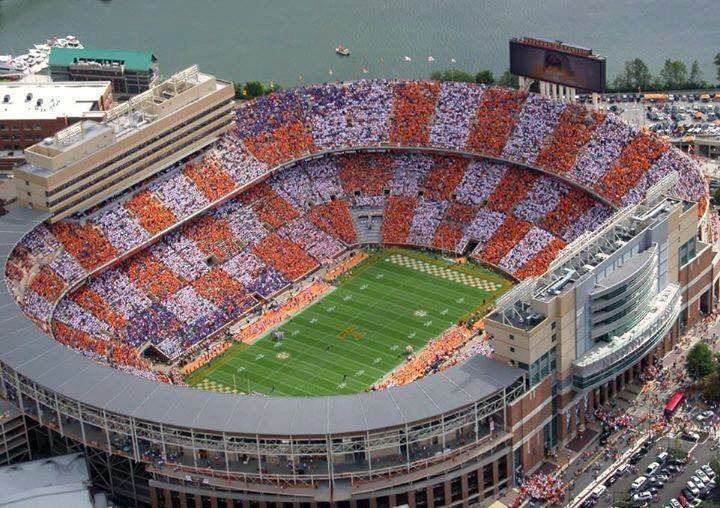
Capacity: 102,455
Year of construction: 1921
Hosted teams: Tennessee Volunteers (American football)
It mostly hosts college football games. In 2004, it held a record number of visitors with 109,061 people during the match between Tennessee Volunteers, the home team, and Florida. Among the most important historical events, we find the Bily Graham Crusade in 1970 in which President Nixon also took part. The Crusade was characterized by thousands of pacifists who tried to stop the demonstration. Renovation works are planned soon to increase the capacity of the upper implant to 10,000 seats.
5. Kyle Field, College Station
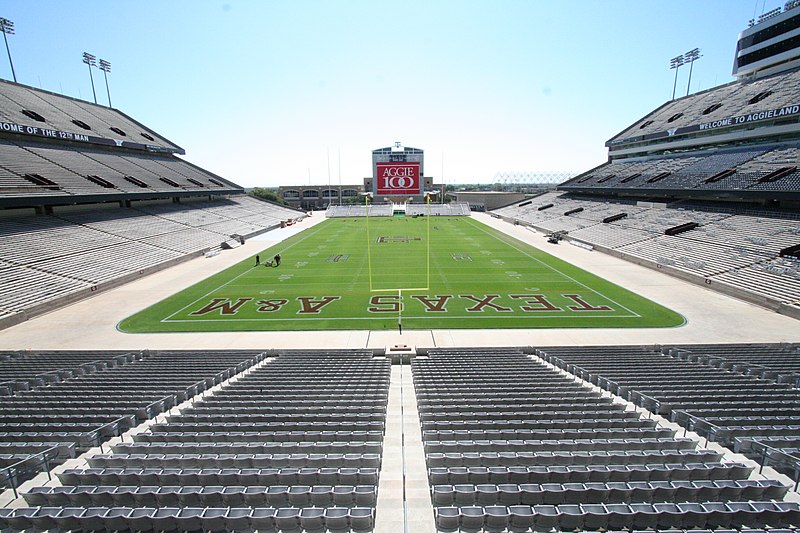
Capacity: 102,733
Year of construction: 1927
Hosted teams: Texas A&M Aggies football (American football)
Also known as “Home of the 12th Man”, this stadium hosts the Aggies’ home games. It’s a stadium that, in the past (in the 90s) proved to be a very lucky playing ground due to the high victory rate of college football, 93.2%. In the past, a small cemetery has also been set up for the team’s mascot dogs, the Reveille. Today, the mascot in charge is Reveille IX. Moreover, all the mascots, in order to fill this prestigious role, must be rough collie females.
4. Ohio Stadium, Columbus
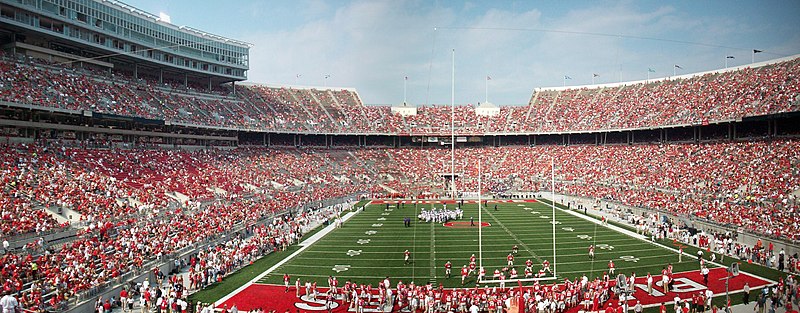
Capacity: 104,944
Year of construction: 1921
Hosted teams: Ohio State Buckeyes
Also known as “The Horseshoe”, this stadium was inaugurated in 1922. Before 2014, it didn’t have a permanent lighting system, which is why there were few games played at night. The stadium hosts the Ohio State Buckeyes home games; however, in the past, it was the playground for MLS matches (American football league) although it was forced to change fields a few years later due to the lack of lighting and the reduced size of the facility. Among the most famous events in the world that took place at this stadium, we find the concerts of Pink Floyd in 1988 and 1994, the Rolling Stones in 1997 and 2015, Genesis, U2, and Metallica.
3. Beaver Stadium, University Park
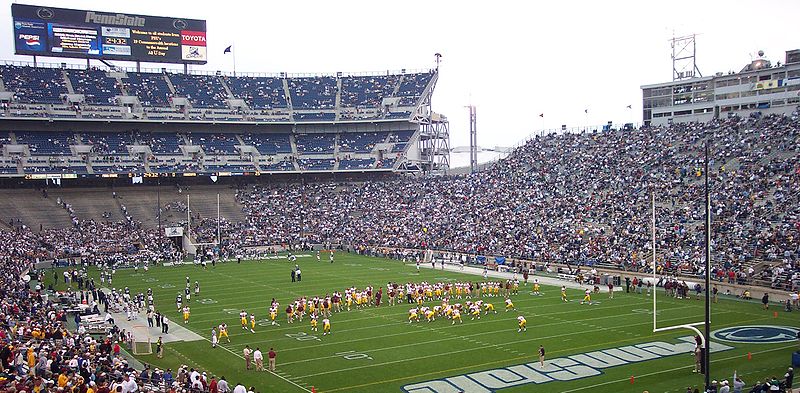
Capacity: 106,572
Year of construction: 1959
Hosted teams: Penn State Nittany Lions (American football)
It was the first-ever stadium to be photographed inside for Google Street View in 2010. Its attendance record was recorded in 2017 at the match between Penn State and Michigan with 110,823 people. It has hosted the Lions of the Penn State Big Ten Conference since 1960 and is named after James A. Beaver, former governor of Pennsylvania and chairman of its university’s board of trustees. What characterizes it the most is the practice of “tailgating”, or eating and drinking near the stadium before the start of any sporting event, very often even with real barbecues set up along the road.
2. Michigan Stadium, Ann Arbor
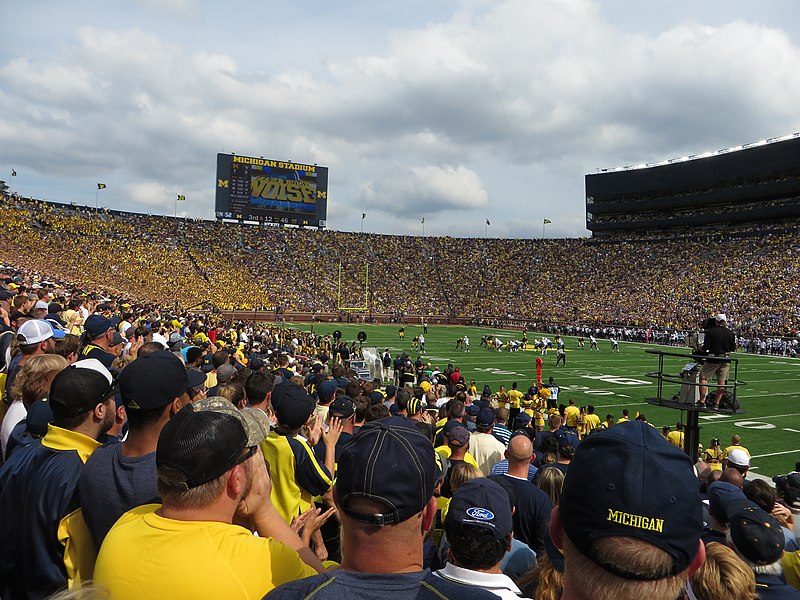
Capacity: 107,601
Year of construction: 1926
Hosted teams: Michigan Wolverines (American football)
Its works began in 1927 and, over the years, it was modernized several times. The record attendance was during the Michigan-Notre Dame match in 2013 with 115,109 people. The facility was nicknamed “The Big House” due to its size and capacity. The stadium is eco-friendly: everything sold inside can be recycled or composted. It is the home stadium of the Michigan Wolverines, the University of Michigan football team, and hosts their games.
1. Rungrado May Day Stadium, Pyongyang
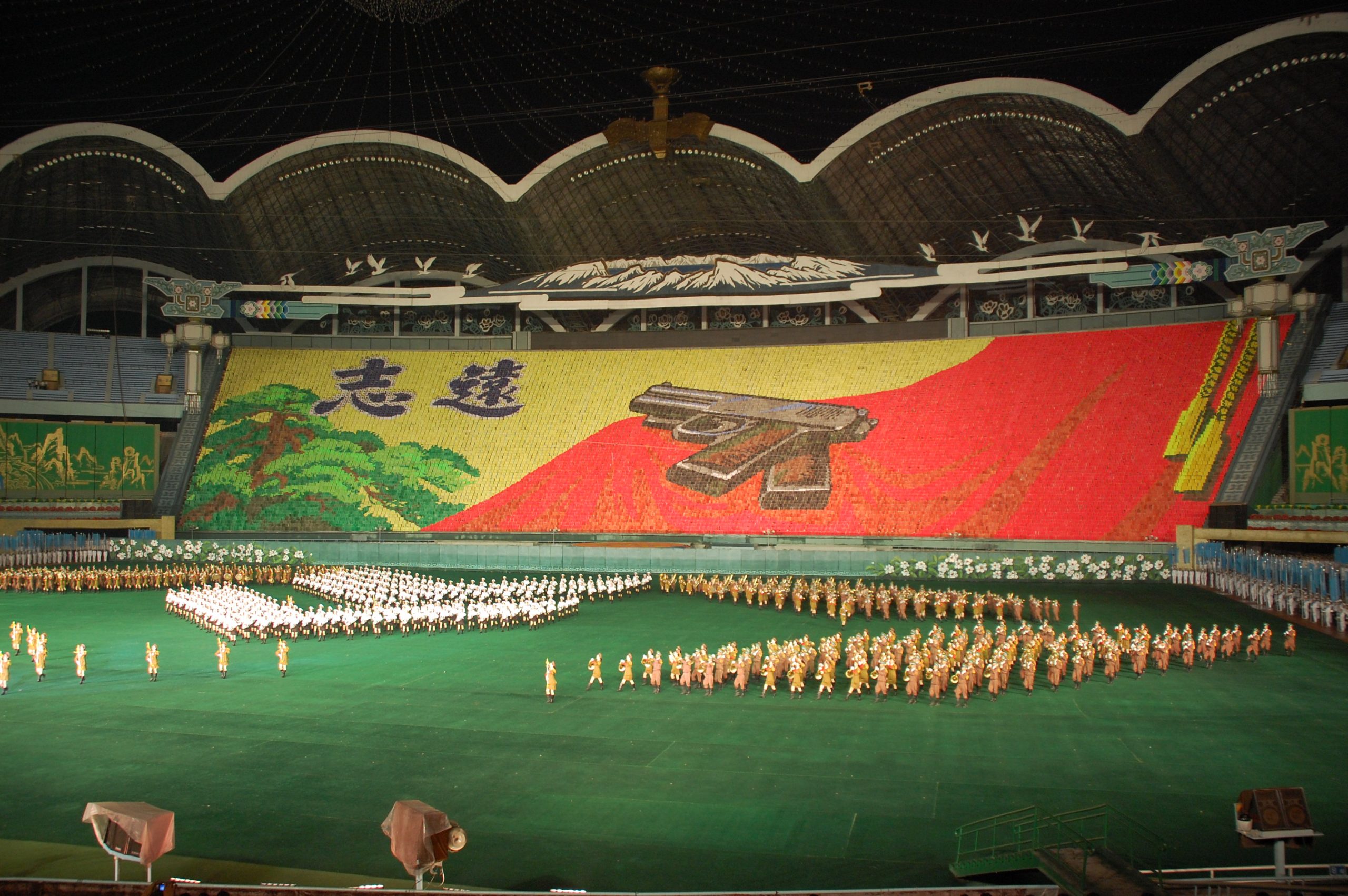
Capacity: 150,000
Year of construction: 1987
Hosted teams: North Korea national team
Also known simply as May Day Stadium, it’s the largest stadium in the world with 150,000 seats, an area of 270,000 square meters, 16 arches representing almost a magnolia, 80 entrances, an indoor swimming pool, a sauna, and many other rooms also used as a relaxation center for players. It was built in about 2 years on Rungra Island, on the Taedong River, and was inaugurated on May 1st, 1980.
The most important show that hosts the stadium is the Arirang Festival, where thousands and thousands of people converge. It’s also known as Guinness World Records, the largest event of its kind in the world, organized every year by the North Korean regime. Furthermore, the stadium is also used for football, especially for the North Korean national team and for athletics events. Other very important and historical events were the PPV Collision in Korea in 1995 (wrestling matches) and the meeting between Kim Jog II and Madeleine Albright, then-Secretary of State of the United States.
Check out these amazing hotel deals!
- Save up to 30% on your hotel in Hawaii!
- Last-minute holiday hotel deals
- Top hotel deals for a new year trip
- Visiting Paris? Find the Best Deals & Reviews at TripAdvisor.
- Save 30% on hotels in Ocean City, Maryland...a TripAdvisor Top 10 Summer Destination!
- Save up to 30% on your hotel on your Winter Vacation!
- Find top-rated hotels at the lowest prices on TripAdvisor. Check rates now!
- Save up to 30% on hotels for a romantic getaway!!
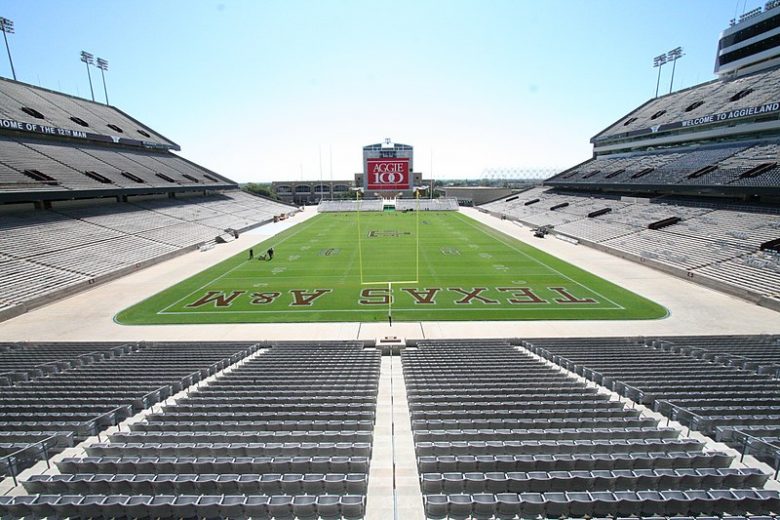




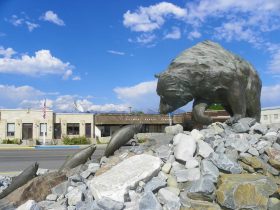
Find Us on Socials